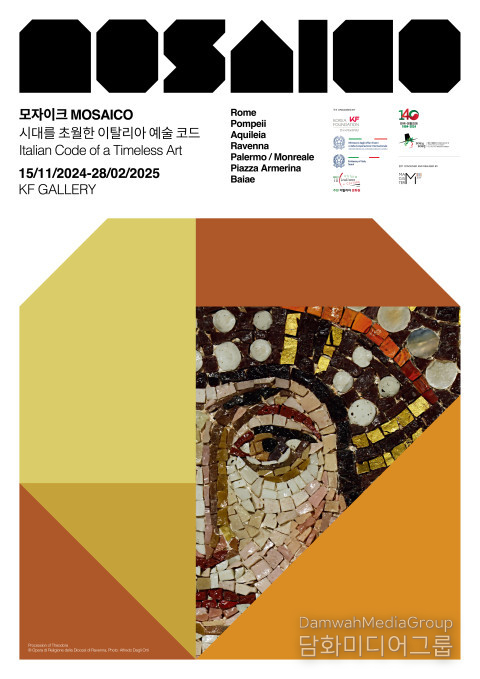By Diplomacy Journal Lee Kap-soo
On the occasion of the celebrations of 140 years of diplomatic relations between Italy and Korea and within the framework of the Year of Cultural Exchange between Italy and Korea proclaimed by two countries, the Italian Embassy in Seoul, the Italian Cultural Institute in Seoul and the Korea Foundation are hosting the exhibition MOSAICO. Italian code of a timeless art from November 15, 2024 to February 28, 2025 at the KF Gallery.

An unprecedented multimedia exhibition to tell the stories of Italy through the precious testimonies of a timeless expressive code: the mosaic. A unique and uninterrupted journey through 2000 years, made of gold artifacts, symbols, allegories, ancient techniques and contemporary creativity, linking together the cities of Rome, Pompeii, Aquileia, Ravenna, Palermo, Monreale, Piazza Armerina and the underwater city of Baiae. The exhibition is Produced by the Directorate General for Cultural Diplomacy of the Italian Ministry of Foreign Affairs and International Cooperation and conceived and realized by Magister Art.
The itinerant and multimedia exhibition with high scenic impact, MOSAICO. Italian code of a timeless art engages the international public in a new emotional exploration to discover the commissions, the images, the materials and gestures that characterise some of the most iconic works in the Italian mosaic world. It is a great promotional event which adds an important piece to the dissemination of Italian culture and art abroad.
Designed for an international audience, the exhibition is an original visual and sound, experiential and emotional journey that explores the profound interconnections between culture and the Italian territory’s history and creativity.
The exhibition itinerary is organised around seven stations, veritable time machines that take the visitors on a 1,500 km journey, linking the north and south of Italy, starting from the Farnesina Collection (the Italian art collection from the 20th and the 21st century of the Ministry of Foreign Affairs and International Cooperation), which showcases works by some of the most important Italian artists who made their mark in mosaic art, leaving indelible traces of technique and creativity.
The first protagonist of this exhibition is Rome, whose glorious past is brought to life by the mosaics housed in the Capitoline Museums, while the masterpieces of two early mediaeval basilicas – the one of Saints Cosmas and Damian in the Roman Forum and the one of Saint Praxedes – tell us about the stories and messages of Christian spirituality.
The history unveiled then moves on to one of the most spacious and luxurious homes in Pompeii, the House of the Faun, where thousands of tiles depict Alexander the Great’s triumph over Darius III of Persia during the Battle of Issus. The floor mosaic in the Basilica of Aquileia changes the perspective between the walls of the second station, which vibrate with the life of a faunal world in an interplay of iconic and allegorical stories, such as that of Jonah, rich in symbols of faith in the aftermath of the Edict of Constantine that granted Christians freedom of worship.
At the third station, dedicated to Ravenna, the spiritual, suspended and otherworldly dimension – captured by the light reflected on the gold of the tesserae of the Mausoleum of Galla Placidia, of the Basilica of Saint Vitale and the Basilica of Saint Apollinaris in Classe – brings the visitor closer to the mosaic as a major tool for the transmission of Christian content. Two stations are dedicated to the majestic mosaic heritage of Sicily: the solemn patronage and syncretic workmanship at the time of Roger II are at the heart of a story that takes us by the hand on a solemn journey through its sacred places, from the Cathedral of Monreale to the Palatine Chapel until the Martorana Church in Palermo. The habits, traditions and customs of the Romans – heroes, gods and gymnasts – unfold along the corridors and in the rooms of an archaeological find of inestimable value: the Villa Romana del Casale in Piazza Armerina whose mosaics offer glimpses of life in the Empire in the first centuries AD.
Lastly, to visit the last station, it will be necessary to figuratively plunge into the waters of the Gulf of Naples: the extraordinary mosaics of the Underwater Archaeological Park of Baiae can only be seen nowadays by those who dive in and scrape the sand by hands in the silence of the seafloor to reveal a flourishing port, the streets, the holiday resorts of the Roman aristocracy and the imperial family through the end of the 3rd century AD.
The contents of the exhibition, featuring a transmedia convergence of archive material, graphic animation, unprecedent audio-visual footage, drone and underwater films, as well as special composed soundtrack, are available in 3 languages (Italian, English and Korean) and may be accessed through a dedicated audio-guide.







